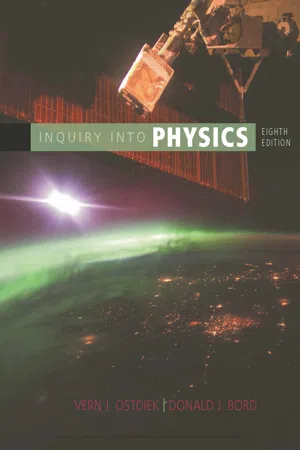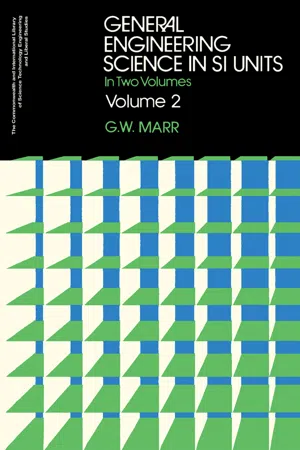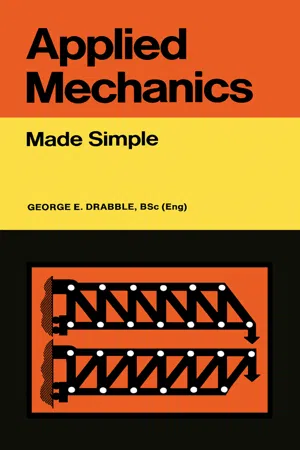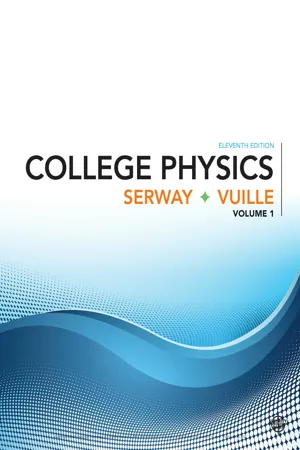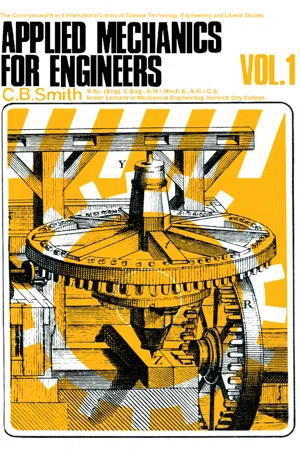Physics
Acceleration
Acceleration is the rate of change of velocity over time. It can be positive (speeding up), negative (slowing down), or zero (constant speed). In physics, acceleration is a vector quantity, meaning it has both magnitude and direction, and is measured in units of distance per time squared (e.g., meters per second squared).
Written by Perlego with AI-assistance
Related key terms
1 of 5
11 Key excerpts on "Acceleration"
- eBook - PDF
- Vern Ostdiek, Donald Bord(Authors)
- 2017(Publication Date)
- Cengage Learning EMEA(Publisher)
(d) can be perpendicular to one of the original velocities. ANSWERS: 1. (c) 2. (a) 3. vector 4. False 5. (b) 1.3 Acceleration The physical world around us is filled with motion. But think about this for a moment: cars, bicycles, pedestrians, airplanes, trains, and other vehicles all change their speed or direction often. They start, stop, speed up, slow down, and make turns. The velocity of the wind usually changes from moment to mo- ment. Even Earth as it moves around the Sun is constantly changing its direc- tion of motion and its speed, though not by much as reckoned on a daily basis. The main thrust of Chapter 2 is to show how the change in velocity of an object is related to the force acting on it. For these reasons, a very important concept in physics is Acceleration. Physical Quantity Metric Units English Units Acceleration ( a ) meter per second 2 (m/s 2 ) foot per second 2 (ft/s 2 ) mph per second (mph/s) Whenever something is speeding up or slowing down, it is undergoing accel- eration. As you travel in a car, anytime the speedometer’s reading is changing, the car is accelerating. Acceleration is a vector quantity, which means it has both magnitude and direction. Note that the relationship between Acceleration and velocity is the same as the relationship between velocity and displacement. Acceleration indicates how rapidly velocity is changing, and velocity indicates how rapidly displacement is changing. EXAMPLE 1.3 A car accelerates from 20 to 25 m/s in 4 seconds as it passes a truck (Figure 1.15). What is its Acceleration? Acceleration Rate of change of velocity. The change in velocity divided by the time elapsed. a 5 D v D t DEFINITION Copyright 2018 Cengage Learning. All Rights Reserved. May not be copied, scanned, or duplicated, in whole or in part. WCN 02-300 26 Chapter 1 The Study of Motion SOLUTION Because the direction of motion is constant, the change in velocity is just the change in speed—the later speed minus the earlier speed. - eBook - PDF
- Fatih Gozuacik, Denise Pattison, Catherine Tabor(Authors)
- 2020(Publication Date)
- Openstax(Publisher)
All you need to know is the change in velocity (i.e., the final velocity minus the initial velocity) and the change in time (i.e., the final time minus the initial time), as shown in the formula. Note that the average Acceleration can be positive, negative, or zero. A negative Acceleration is simply an Acceleration in the negative direction. Keep in mind that although Acceleration points in the same direction as the change in velocity, it is not always in the direction of the velocity itself. When an object slows down, its Acceleration is opposite to the direction of its velocity. In everyday language, this is called deceleration; but in physics, it is Acceleration—whose direction happens to be opposite that of the velocity. For now, let us assume that motion to the right along the x-axis is positive and motion to the left is negative. Figure 3.2 shows a car with positive Acceleration in (a) and negative Acceleration in (b). The arrows represent vectors showing both direction and magnitude of velocity and Acceleration. Figure 3.2 The car is speeding up in (a) and slowing down in (b). 94 Chapter 3 • Acceleration Access for free at openstax.org. Velocity and Acceleration are both vector quantities. Recall that vectors have both magnitude and direction. An object traveling at a constant velocity—therefore having no Acceleration—does accelerate if it changes direction. So, turning the steering wheel of a moving car makes the car accelerate because the velocity changes direction. Calculating Average Acceleration Look back at the equation for average Acceleration. You can see that the calculation of average Acceleration involves three values: change in time, (Δt); change in velocity, (Δv); and Acceleration (a). Change in time is often stated as a time interval, and change in velocity can often be calculated by subtracting the initial velocity from the final velocity. Average Acceleration is then simply change in velocity divided by change in time. - eBook - PDF
- James Shipman, Jerry Wilson, Charles Higgins, Bo Lou, James Shipman(Authors)
- 2020(Publication Date)
- Cengage Learning EMEA(Publisher)
Changes in motion can be sensed if they are appreciable. Think about being in a smooth-riding car and blindfolded. Minor changes in velocity would go unnoticed, but you would be able to tell if the car suddenly sped up, slowed down, or went around a sharp curve, all of which are changes in velocity. A change in velocity is called an Acceleration, the topic of the following sections. Did You Learn? ● ● Speed is a scalar (magnitude), and velocity is a vector (magnitude and direction). ● ● Distance (actual path length) is always greater than or equal to the magnitude of displacement (straight-line distance). 2.3 Acceleration Key Questions ● ● What motional changes produce an Acceleration? ● ● Is a negative Acceleration (2a) necessarily a deceleration? When you are riding in a car on a straight interstate highway and the speed is suddenly increased—say, from 45 mi/h to 60 mi/h (72 km/h to 97 km/h)—you feel as though you are being forced back against the seat. If the car then whips around a circular cloverleaf, you feel forced to the outside of the circle. These experiences result from changes in velocity. Because velocity is a vector quantity, with both magnitude and direction, a change in velocity involves either or both of these factors. Therefore, an Acceleration may result from 1. a change in speed (magnitude), 2. a change in direction, or 3. a change in both speed and direction. Copyright 2021 Cengage Learning. All Rights Reserved. May not be copied, scanned, or duplicated, in whole or in part. Due to electronic rights, some third party content may be suppressed from the eBook and/or eChapter(s). Editorial review has deemed that any suppressed content does not materially affect the overall learning experience. Cengage Learning reserves the right to remove additional content at any time if subsequent rights restrictions require it. 2.3 Acceleration 35 When any of these changes occur, an object is accelerating. - eBook - PDF
General Engineering Science in SI Units
The Commonwealth and International Library: Mechanical Engineering Division
- G. W. Marr, N. Hiller(Authors)
- 2013(Publication Date)
- Pergamon(Publisher)
Section 2 Velocity and Acceleration 2.1. Motion When the position of one body relative to another is continuously changing the bodies are said to be in relative motion. Motion, in fact, is always relative. In very many cases we are concerned with the motion of a body relative to the earth, and in such cases the word relative is generally omitted. We are accustomed to refer-ring simply to the motion of a motor vehicle or aircraft. We may say, for example, that a caj* is travelling at a speed of 30 km/h. When we do so, it must be understood that the speed is relative to the earth. 2.2. Velocity The velocity of a body is the rate at which the body is changing its position. Because direction is involved, velocity is a vector quantity. The magnitude, or numerical value, of a velocity is called the speed. The average speed of a body during a given interval of time IS measured by the ratio total distance^raven.d in given time W h e n a body travels equal distances during equal intervals of time, what-ever the magnitude of the time interval, the body is said to travel with constant speed. A velocity may change because of change in speed, or in the direction of motion or because of a change v in both of these. 32 VELOCITY AND Acceleration When a body moves in such a way that its velocity does not change, it is said to move with constant, or uniform, velocity. Hence to move with uniform velocity, a body must travel at constant speed in a straight line. EXAMPLE. A vehicle travels a distance of 840 m in 30 sec. Express its average speed in km/h. Distance travelled = 840 m = 0-84 km. 30 s = ai 0-84 km Time interval = 30s = g§öö h = iiö-h .*. average speed — —j = 100-8 km/h. EXAMPLE. The straight-line distance between two towns, A and B, is 49 km. Town A is due north-west from B. The road distance between the towns is 56 km. A motorist leaves A at 13.20 h and arrives at B at 14.10 h. Calculate (a) his average speed; (b) his average velocity. - eBook - PDF
General Engineering Science in SI Units
In Two Volumes
- G. W. Marr, N. Hiller(Authors)
- 2016(Publication Date)
- Pergamon(Publisher)
Section 2 Velocity and Acceleration 2.1. Motion When the position of one body relative to another is continuously changing the bodies are said to be in relative motion. Motion, in fact, is always relative. In very many cases we are concerned with the motion of a body relative to the earth, and in such cases the word relative is generally omitted. We are accustomed to refer-ring simply to the motion of a motor vehicle or aircraft. We may say, for example, that a car is travelling at a speed of 30 km/h. When we do so, it must be understood that the speed is relative to the earth. 2.2. Velocity The velocity of a body is the rate at which the body is changing its position. Because direction is involved, velocity is a vector quantity. The magnitude, or numerical value, of a velocity is called the speed. The average speed of a body during a given interval of time is measured by the ratio total distance um^d m given time w h e n a body travels equal distances during equal intervals of time, what-ever the magnitude of the time interval, the body is said to travel with constant speed. A velocity may change because of change in speed, or in the direction of motion or because of a change in both of these. 32 VELOCITY AND Acceleration When a body moves in such a way that its velocity does not change, it is said to move with constant, or uniform, velocity. Hence to move with uniform velocity, a body must travel at constant speed in a straight line. EXAMPLE. A vehicle travels a distance of 840 m in 30 sec. Express its average speed in km/h. Distance travelled = 840 m = 0-84 km. Time interval = 3 0 s = a|ööh = 1 ^-h 0-84 km .·. average speed = —j I2Ö h = 100-8 km/h. EXAMPLE. The straight-line distance between two towns, A and B, is 49 km. Town A is due north-west from B. The road distance between the towns is 56 km. A motorist leaves A at 13.20 h and arrives at B at 14.10 h. Calculate (a) his average speed; (b) his average velocity. - eBook - PDF
Applied Mechanics
Made Simple
- George E. Drabble(Author)
- 2013(Publication Date)
- Made Simple(Publisher)
It is not quite so easy (although I hope not too difficult) to appreciate that Acceleration occurs when the velocity changes in direction as well as magni-tude. A car travelling at a constant speed around a bend is in a state of Acceleration. The magnitude of this Acceleration is determined by the speed of the car and the radius of the bend. (4) Motion in a Straight Line Although straight-line motion is the exception rather than the rule in applied mechanics, it forms a simple introduction to the determination of Acceleration. This is because we can forget about the change of direction of velocity, and concentrate on the change of magnitude. The Nature of Motion 13 In Fig. 4 the symbols x, v, a and t represent displacement, velocity, accelera-tion and time, respectively. The three graphs in column (a) show how the first three of these quantities vary with time, for a condition of zero accelera-tion. It is seen that the velocity remains constant (as it must for this con-dition, by definition of the term Acceleration) and that the displacement increases steadily, the displacement graph being a straight line. (In the terms of applied mechanics, the displacement is said to vary linearly with time.) An example of this type of motion would be that of a car travelling at steady speed along a straight level road. In column (b) I have assumed a state of affairs in which the Acceleration is constant. It is now the velocity which increases uniformly (and linearly) with time. If the Acceleration is 4 metres per second per second, the velocity will be 16 metres per second after 4 seconds, will be 24 metres per second after 6 seconds, and so on. But since the speed is increasing all the time, it follows that the distance covered (i.e. the displacement x) will increase at a pro-gressively-increasing rate, and the graph will be a curve of the form shown. This particular form of graph is called a parabola and will be familiar to many readers. - eBook - PDF
Workshop Physics Activity Guide Module 1
Mechanics I
- Priscilla W. Laws, David P. Jackson, Brett J. Pearson(Authors)
- 2023(Publication Date)
- Wiley(Publisher)
UNIT 4: MOTION WITH CONSTANT Acceleration 101 SPEEDING UP, SLOWING DOWN, AND TURNING AROUND 4.2 DESCRIBING VELOCITIES AND AccelerationS Describing Velocities The term speed is familiar to most students as a description of how fast or slow an object is moving. The speed can be calculated by taking the distance traveled and dividing by the time it takes to move this distance. The term velocity, on the other hand, is used less frequently and is calculated by taking the change in position and dividing by the time interval. Whereas the speed only tells us how fast the object moves, the velocity also tells us the direction of motion. For an object moving in one dimension, we saw that the change in position can be positive or negative, and this sign tells us the direction that the object is moving (in the positive x-direction or the negative x-direction). Natursports/Shutterstock As we continue our study of motion we will find that the use of certain terms can lead to confusion. In particular, the terms larger and smaller can be ambiguous when describing velocities. For example, the term “larger velocity” could mean that an object is moving at a faster speed, or perhaps that the velocity is more positive (even though the object is moving slower). Thus, when com- paring velocities, the terms greater than, less than, larger than, and smaller than should be used with caution (or avoided altogether). A less ambiguous way to compare velocities is to refer explicitly to the speed (magnitude of velocity) and direction (relative to the chosen coordinate system). Describing Accelerations When describing Accelerations the same kinds of ambiguities can arise. However, there is not an analogous word like “speed” for the magnitude of accel- eration. Therefore, when describing Accelerations we will simply refer to the magnitude of Acceleration as being larger or smaller, as well as specifying its direction (positive or negative for one-dimensional motion). - eBook - PDF
- Raymond Serway, Chris Vuille(Authors)
- 2017(Publication Date)
- Cengage Learning EMEA(Publisher)
Because the velocity and Acceleration vectors are in the same direc- tion, the speed of the car must increase as the car moves to the left. Positive and negative Accelerations specify directions relative to chosen axes, not “speeding up” or “slowing down.” The terms speeding up or p or p slowing down refer to an increase and a n refer to an increase and a n decrease in speed, respectively. Quick Quiz 2.2 True or False? (a) A car must always have an Acceleration in the same direction as its velocity. (b) It’s possible for a slowing car to have a positive Acceleration. (c) An object with constant nonzero Acceleration can never stop and remain at rest. An object with nonzero Acceleration can have a velocity of zero, but only instan- taneously. When a ball is tossed straight up, its velocity is zero when it reaches its maximum height. Gravity still accelerates the ball at that point, however; otherwise, it wouldn’t fall down. Instantaneous Acceleration The value of the average Acceleration often dif- f- f fers in different time intervals, so it’s useful to define the instantaneous accelera- - tion, which is analogous to the instantaneous velocity discussed in Section 2.1.2. The instantaneous Acceleration a is the limit of the average Acceleration as a is the limit of the average Acceleration as a the time interval Dt goes to zero: t goes to zero: t a ; lim Dt S0 Dv Dt [2.5] SI unit: meter per second per second (m/s 2 ) Here again, the notation lim Dt S0 means that the ratio Dv/ / Dt is evaluated for smaller is evaluated for smaller and smaller values of Dt. The closer Dt gets to zero, the closer the ratio gets to a t gets to zero, the closer the ratio gets to a t fixed number, which is the instantaneous Acceleration. Tip 2.6 N egative Acceleration Negative Acceleration doesn’t nec- essarily mean an object is slowing down. - eBook - PDF
Applied Mechanics for Engineers
The Commonwealth and International Library: Mechanical Engineering Division
- C. B. Smith, N. Hiller, G. E. Walker(Authors)
- 2013(Publication Date)
- Pergamon(Publisher)
CHAPTER 4 Velocity and Acceleration Velocity Velocity is rate of change of position with respect to time, so it is necessary to specify its magnitude, direction and the datum with respect to which it is measured. EXAMPLE 4.1. A motor-car travelling along a straight road has a velocity of 60 mile/h or 88 ft/sec relative to the road. A second car approaching from the opposite direction has a velocity of 30 mile/h or 44 ft/s relative to the road. Then the velocity of the second car relative to the first car is 90 m.p.h. or 132 ft/s, which it will be seen is the difference between the velocities of the two cars relative to the road allowing for the fact that one car is going in the opposite direction to the other. Like force, a velocity is a vector quantity and may be represented by a line; the length of the line being the magnitude of the velocity and its position showing the direction. Problems in relative velocity may be dealt with either by cal-culation or by graphical construction. EXAMPLE 4.2. A cyclist is travelling due north at 15 mile/h in a wind blowing from the south-east at 20 mile/h. Find the direction in which a flag mounted on the front of his cycle will point. Calculation. Velocity of cycle relative to the ground in a northerly direction = 15 mile/h. Velocity of wind relative to ground in a northerly direction = 20 sin 45° = 20x0-7071 = 14-142 mile/h. 71 72 APPLIED MECHANICS FOR ENGINEERS Λ velocity of wind relative to cycle in a northerly direction = vel. of wind—vel. of cycle = 14-142-15 = -0-858 mile/h. Velocity of cycle relative to ground in a westerly direction = 0 mile/h. Velocity of wind relative to ground in a westerly direction = 20 cos 45° = 20x0-7071 = 14-142 mile/h. .*. velocity of wind relative to cycle in a westerly direction = 14-142-0 = 14-142 mile/h. .'. actual velocity of wind relative to cycle = y/( — 0-858) 2 + (14-142) 2 = 14-17 m.p.h. and this will be in a direction 14-142 t a n 1 — — — = t a n 1 -16-48^93° 31' W. - Raymond Serway, John Jewett(Authors)
- 2018(Publication Date)
- Cengage Learning EMEA(Publisher)
By definition, this limit equals the derivative of x with respect to t , or the time rate of change of the position: v x ; lim Dt S0 Dx Dt 5 dx dt (2.5) The instantaneous speed of a particle is equal to the magnitude of its instantaneous velocity. The average Acceleration of a particle is defined as the ratio of the change in its velocity Dv x divided by the time interval Dt during which that change occurs: a x,avg ; Dv x Dt 5 v xf 2 v xi t f 2 t i (2.9) The instantaneous Acceleration is equal to the limit of the ratio Dv x /Dt as Dt approaches 0. By definition, this limit equals the derivative of v x with respect to t , or the time rate of change of the velocity: a x ; lim Dt S0 Dv x Dt 5 dv x dt (2.10) › Concepts and Principles When an object’s velocity and Acceleration are in the same direction, the object is speeding up. On the other hand, when the object’s velocity and Acceleration are in opposite directions, the object is slowing down. Remem- bering that F x ~ a x is a useful way to identify the direction of the Acceleration by associating it with a force. An object falling freely in the presence of the Earth’s gravity experi- ences free-fall Acceleration directed toward the center of the Earth. If air resistance is neglected, if the motion occurs near the surface of the Earth, and if the range of the motion is small compared with the Earth’s radius, the free-fall Acceleration a y 5 2g is constant over the range of motion, where g is equal to 9.80 m/s 2 . Complicated problems are best approached in an organized manner. Recall and apply the Conceptualize, Categorize, Analyze, and Finalize steps of the Analysis Model Approach to Problem Solving when you need them. An important aid to problem solving is the use of analysis models. Analysis mod- els are situations that we have seen in previous problems. Each analysis model has one or more equations associated with it. When solving a new problem, identify the analysis model that corresponds to the problem.- eBook - PDF
- John Matolyak, Ajawad Haija(Authors)
- 2013(Publication Date)
- CRC Press(Publisher)
25 © 2010 Taylor & Francis Group, LLC Motion in One Dimension This chapter addresses deriving and using the equations of motion that describe the time depen-dence of an object’s displacement, velocity, and Acceleration. Relationships between displacement, velocity, and Acceleration are also of importance and will be derived. This chapter starts with the basic definitions of displacement and average velocity of an object moving in one dimension. Such a simplified start will help to lead a complete set of equations of motion for an object moving along one dimension, east–west, north–south, or up and down. In the context of coordinate systems that were treated in the previous chapter, the one-dimensional motion will reduce the time and effort needed on the study of motion in two dimensions, which is the subject of the next chapter. 2.1 DISPLACEMENT Motion can be defined as a continuous change in position and that change could occur in one, two, or three dimensions. As the treatment here will be limited to motions only in one dimension, one axis of the coordinate system described in Chapter 1 will suffice. Choosing this axis as the x-axis, we depict on it a point, O, which will be considered as an origin of zero coordinate. Any point on the right of the origin O will have a positive coordinate and any point on the left of O will have a negative coordinate (Figure 2.1). The displacement, denoted by Δ x, of an object as it moves from an initial position x i to a final position x f along the x-axis can be defined as the change in the object’s position along the x-axis. That is Δ x = x f – x i . (2.1) 2.1.1 S PECIAL R EMARKS The quantities in Equation 2.1 are treated as vectors. x i is the initial position vector, x f the final posi-tion vector, and Δ x the displacement vector. Accordingly, all these quantities have a direction and magnitude.
Index pages curate the most relevant extracts from our library of academic textbooks. They’ve been created using an in-house natural language model (NLM), each adding context and meaning to key research topics.
